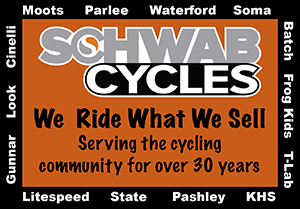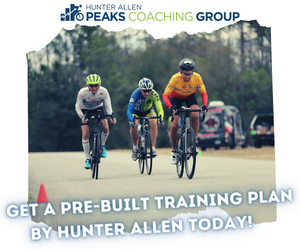

Three Tips for Winter
By PCG Founder & Coach Hunter Allen
Back to list of our training, coaching and nutrition essays

Les Woodland's book Cycling's 50 Craziest Stories is available as an audiobook here. For the print or Kindle eBook versions, just click on the Amazon link on the right.
Hunter Allen writes:
Over the years, I usually teach fall camps and teach power seminars around the world, I have been able to ride with many different cyclists and teach to diverse groups ranging from Gold medal winning Olympians and their coaches to beginning cyclists that have never used a power meter. Teaching to diverse groups is always a challenge, but at the same time forces me to teach with clarity, focus and patience.
A common question that I get in the “fall” of each year in my seminars and camps is: “I really want to improve this winter, what are 3 things I can do to really make a difference.” A broad and general question of course, and the great thing about being a cycling coach is that pretty much the answer to every question begins with, “It depends……”. There are many factors that go into improvement and lots of things that affect improvement, so there is no easy answer. We are each highly individual and respond differently to different training stimulus along with having different goals at different parts of the year. So, before I can answer a broad question, I have to dig a little deeper and learn more about the athlete, their goals, time constraints and strengths and weaknesses.
These basics create the foundation of my answers and from there, I can build actionable answers for the athlete. Thinking of the basics of cycling is where we all have to start in order to improve and therefore let’s consider three solid, basic, fundamentals that can help you or any cyclist this winter to improve and make the coming season great.

Hunter Allen (center) with some fellow sufferers
Cycling is an aerobic sport and this means you will need to have the highest output of wattage possible in order to give yourself the chance to be successful (you can be the strongest person in the peloton and still lose!). The higher your FTP, the fitter you are, and more likely you will be to succeed in your given event. For that big Gran Fondo in March or that first long road race of the year in April, you WILL do better if your FTP is higher than it is now. So, first and foremost, you must always consider doing everything you can to improve your FTP. That’s the number one thing you can do this winter to improve your chances for more success in the comng season.
What does that practically mean though? What kind of workouts should you do, how often and when? The answers to these questions have more to do with when your season will begin and how far away your first race is from now and beyond the scope of this article. Right now, though, this December, you need to be riding in your Tempo and Sweet-Spot/Sub-Threshold power levels. These zones fall between 76-90% with Sweet-Spot/Sub-Threshold between 88-93%.
Start out with intervals at the 20-minute mark and your intensity around 85% of your FTP, and then build the time and intensity until you can do at least 45 minutes at 93% of your FTP. It’s perfectly fine to break these into smaller portions, but don’t do anything less than 20 minutes as that will give you enough time at that intensity to make sure you are improving your aerobic fitness.
I really like doing 30-minute efforts at Sweet-Spot as they are challenging both physically and mentally and I can just complete the 30 minutes with enough mental games. This workout should be done at least twice each week in December and increasing to three times a week in January and February.
Again, the main goal is increasing your aerobic fitness/FTP and if you can do that, then you’ll be on the way to creating an excellent racing season.

Big Gear intervals. Yup, that’s number two. Once a week, I want you to work on “applicable strength”. This means strength that you can apply to making the bike go faster and not strength that will help you squat a piano on your back or carry a couch up 8 flights of stairs. It also is NOT about pushing a big gear for 30 minutes. It’s not even doing it for one minute! This type of big gear work is not increasing your muscular strength and just makes you better at pushing a marginally harder gear in a slower than normal cadence, but not really helping your on-the-bike strength.
This is done by slowing your speed down to 5-8mph, putting the bike in a 53:13 gear, gripping the handlebars tightly, tightening your abdominals, and while staying seated the entire time, exploding with force on the pedals and getting that gear to 85-90rpm. You will grunt and strain and think you might rip the handlebars right off the stem, but eventually you’ll get to 85-90rpm start feeling the “burn”. Then it’s over. That’s it. Not long, but with lots of strength.
The effort has been completed and now you are ready to recover those muscles for another “feat of strength”, so give yourself at least 3-4 minutes between each effort. These are very similar to “standing starts” in Track Racing and I was privy to a “standing start” practice/training session with the top sprinter on the New Zealand track team this past month and he was doing almost identical efforts as the above. He did them for 45 minutes with solid 5 minutes of rest between each to make sure he could get the maximum effort out in each.
Here, the effort must be in Quadrant II of the Quadrant Analysis chart, see figure 2. This means that you are putting out maximum force with lower cadence and once you cross over into a faster cadence (over 90rpm), then you are no longer in the correct quadrant.

Long rides when its nice out. That’s #3. Every time from now until April, if it’s nice out (and you live in a normally cold area), then go for a long ride. Throw away the training plan for that day (or even better, integrate it into a long ride) and go for a 4-5-6 hour ride. You don’t know when the next nice day will be, so you need to get in those long rides in order to increase your endurance and aerobic efficiency. It’s the long rides that will take you to the next level of fitness with a higher FTP and more fatigue resistance and unfortunately this is no short cut.
You have to get out there and put in the longer miles. I have talked to many master riders over the years and when they have gotten “stuck” at a certain wattage for their threshold, they always ask how they can get to the next level and why they are “stuck” there. The answer is the same for all and that is: Longer rides! You don’t think Jens Voigt’s FTP is 460watts because he only rode for 2 hours day do you? No, if you want an FTP higher than 250 watts than you are going to have to do AT LEAST (2) rides a month that are longer than 5 hours.
What should you do in these rides? I would make sure that the majority of the ride is in the Zone 2-endurance range, but then also be sure to get in one solid section of 45 minutes at your Sweet Spot and also do 20 fast pedaling efforts at 110rpm+ for one minute each resting a minute between them. The goal is to come home tired like you finished a long ride, but not crushed like you “barely” finished a long ride. It’s just that simple (and difficult). Longer rides increase the stress on the aerobic and muscular system and that in turn causes it to adapt and get stronger which results in a higher FTP. Nothing can substitute a long ride and this is a key for you to increase your FTP this coming season. Even if your longest race is 2 hours, you still have to ride big long rides if you want to improve your FTP above that 250watt “Glass ceiling”.
That’s it , those are the three things you need to do to improve for this winter. They also apply to just about everyone and in the coaching world is hard to do, but if you only did those three things, you would be moving in the right direction and toward a very strong season. With regards to training with power, you have to remind yourself that these ideas came from the “demands of the event” first, then wattage based workouts were born from them. While you don’t have a specific focus of wattages for the big gear intervals, you have a quadrant that you need to adhere to in order to ensure you are training properly.
Use your power meter to train to the demand of your events, use your power meter to help guide your individual sessions, use your power meter to hone in on your training zones and then analyze the data afterward to make sure you are on track for new peaks!
Hunter Allen is a USA Cycling Level 1 coach and former professional cyclist. He is the coauthor of “Training and Racing with a Power Meter” and “Cutting-Edge Cycling,” co-developer of TrainingPeaks’ WKO software, and CEO and founder of Peaks Coaching Group. He and his coaches create custom training plans for all levels of athletes.
.









